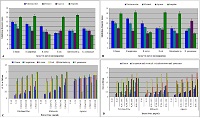Antibacterial Evaluation of Plant Extracts: An Insight into Phytomedicine
Keywords:
Antibacterial activity, O. sanctum, P. nigrum, PhytomedicineAbstract
This study was carried out to evaluate the antibacterial activity of petroleum ether, methanol and aqueous extract of the two plant Ocimum sanctum and pepper nigrum extract using agar well diffusion and broth dilution method against gram-positive bacterial strains (B. firmus, B. megaterium and B. cereus) and gram-negative bacterial strains (Escherichia coli, Enterobacter sp. and Klebsiella pneumoniae). The results indicate that petroleum ether extract compare to methanol and aqueous extract of O. sanctum and P. nigrum exhibited significant antibacterial activity against gram-positive bacteria with minimum inhibitory concentration (MIC) ranging from 0.13 to 0.21x 10-4 mg/well concentration. Moreover, gram-negative bacteria were less susceptible against petroleum ether, methanol and aqueous extract of O. sanctum and P. nigrum and their MIC ranging from 0.13 to 0.21x 10-2. The most susceptible organism to the organic extracts from both studied plants was B. firmus and the most resistant organism was Enterobacter sp. The result obtained with B. cereus and K. pneumoniae were particularly interesting, since it was inhibited by antibiotic ampicillin used and susceptibility was observed with the individual extracts, where higher antibacterial activity with petroleum ether and aqueous extracts of O. sanctum and P. nigrum respectively. The presence of phytochemicals such as alkaloids, tannins, saponin, triterpenoids, steroids and glycosides in the extracts of these plants supports their traditional uses as medicinal plants for the treatment of various ailments. The present study reveals potential use of these plants for developing new antibacterial herbal drugs against pathogenic microorganisms.
References
. Kuete V, Kamga J, Sandj LP,
Ngameni B, Poumale HMP,
Ambassa P, Ngadjui B.
Antimicrobial activities of the
methanol extract, fractions and
compounds from Ficus polita Vahl.
(Moraceae). BMC Complementary
Alternative Med. 2011; 11(1): 1-6
. Alam MT, Karim MM, Khan SN.
Antibacterial activity of different
organic extracts of Achyranthes
aspera and Cassia alata. J. Sci.
Res. 2009; 1(2): 393-398.
. Nascimento GGF, Locatelli J,
Freitas PC, Silva GL. Antibacterial
activity of plant extracts and
phytochemicals on antibiotic
resistant bacteria. Braz. J.
Microbiol. 2000; 31(4): 247-256.
. Cowan MM. Plant products as
antimicrobial agents. Clin.
Microbiol. Rev. 1999; 12(4): 564-
. Amit R, Shailandra S.
Ethnomedicinal approach in
biological and chemical
investigation of phytochemicals as
antimicrobials. Indian J Pharma.
Sci. 2006; 4(2): 1-13.
. Aibinu I, Adenipekun T,
Adelowotan T, Ogunsanya T,
Odugbemi T (2007). Evaluation of
the antimicrobial properties of
different parts of Citrus aurantifolia
(lime fruit) as used locally. Afr. J.
Trad. Complement Altern Med.
; 4(2): 185-190.
. Govindarajan VS. Pepper
Chemistry, Technology and
Quality Evaluation. Crit Rev Food
Science Nutr. 1980; 9 (2): 115-
. Perez C, Anesini C. Antibacterial
activity of alimentary plants against
Staphylococcus aureus growth.
Am. J. Chin. Med. 1994; 22 (2):
-174.
. Singh G, Marimuthu P, Murali
HSand Bawa AS. Antoxidative and
antibacterial potentials of essential
oils and extracts isolated from
various spice materials. J Food
Safety 2005; 25(2): 130-145.
. Cappuccino JG, Sherman, N. The
bacterial growth curve.
Microbiology: A Laboratory
Manual. Benjamin Cummings,
California, 2005. P. 135–137.
. Mathabe MC, Nikolova RV, Lall N,
Nyazema NZ. Antibacterial
activities of medicinal plants used
for the treatment of diarrhoea in
Limpopo Province, South Africa. J
Ethnopharmacol. 2006; 105(1-2):
–293.
. Ravindran PN. Black Pepper:
Piper nigrum. Series: Medicinal
and Aromatic Plants - Industrial
Profiles. Center for Medicinal
Plants Research, Kerala, India.
CRC Press, 2000. p. 1-526.
. Ao P, Hu S, Zhao A. Essential oil
analysis and trace element study
of the roots of Piper nigrum L.
Zhongguo Zhong Yao Za Zhi.
; 23(1): 42-43.
. Rastogi, RP, Mehrotra BN.
Glossary of Indian Medicinal
Plants. National Institute of
science communication, New
Delhi, India, 2002.
. Burt S. Essential oils: Their
antibacterial properties and
potential applications in foods-A
review, Int J Food Microbiol. 2004;
(3): 223-253.
. Okigbo RN, Ogbonnanya OU.
Antifungal effects of two tropical
plants extracts Ocimum
gratissimum and Afromaomum
melegueta on post harvest yam
Discorea spp rot. Afr. J.
Biotechnol. 2006; 5(9): 727-731.
. Amadioha AC, Obi VI Control of
anthracnose disease of cowpea by
Cymbopogon citrates and Ocimum
gratissimum. Acta. Phytopathol.
Entomol. Hungerica 1999; 34(1-2):
-89.
. Okigbo RN, Ajale AN. Inhibition of
some human pathogens with the
tropical plant extracts
Chromolineena odorata and Citrus
aurantifolia and some antibiotics.
Int. J. Mol. Med. Adu Sci. 2005; 1:
-40
. Okigbo RN, Mbajaka C, Njoku CO.
Antimicrobial potential of (UDA)
Xylopia aethopica and Ocimum
gratissimum on some pathogens
of man. Int J. Mol. Med. Ad. Sci.
Pakistan. 2005; 1(4): 392-394.
. Agatemor C. Antimcrobial activity
of aqueous and ethanol extracts of
nine Nigerian spices against four
food borne bacteria. Elec. J.
Environ. Agric. food chem. 2009;
: 195-200.
. Sikkema J, De Bont JAM,
Poolman BM. Interaction of cyclic
hydrocarbons with biological
membranes. J. Biol. Chem. 1994;
(11): 8022–8028.
. Cheesbrough M. Medicinal
laboratory manual for tropical
countries, ELBS reprinted Edition.
. Sydney S, Lacy RW, Bakhtiar M.
In: The Betalactam antibiotics
Penicillin and Cephalosporin in
perspective, Hodder and stongton,
London. 1980; p. 224.
. Cunha BA. Antibiotics side
effects. Med. Clin. North Am.
; 85 (1): 149-185.
. Vermani K, Garg S (2002). Herbal
medicine for sexually transmitted
diseases and AIDS. J.
Ethnopharmacol. 2002; 80(1): 49-



